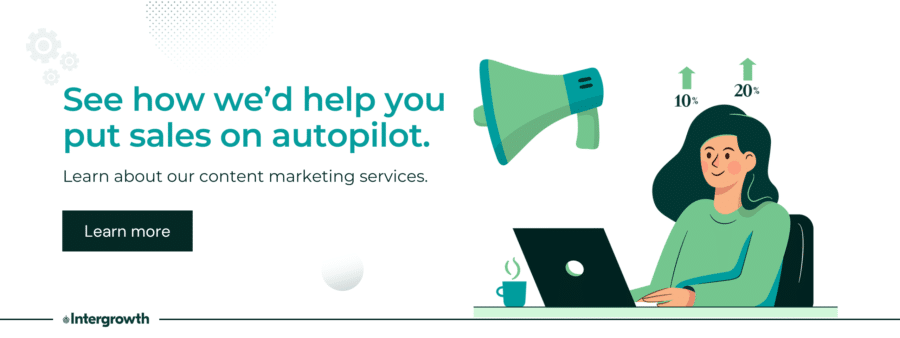Your website has a lot of unlocked revenue potential hiding in it.
Maybe there are some old sales pages that could start driving more conversions if you made a few tweaks.
Or maybe some of those underperforming blogs could get back up to the top of Google if you updated them.
You can identify these types of opportunities by running a content review.
The Purpose of a Content Review
A content review is a full audit of all the text, images, and design features of your website.
It allows you to identify opportunities for improvement, such as fixing broken backlinks, rewriting old blog articles, or redesigning page layouts.
During your content review, you’ll analyze the performance of every page on your website so you know which ones are performing well and which ones are not.
Then you’ll know what you need to fix.
Ultimately, it will help increase traffic to your site.
How to Conduct a Content Review
Here’s a way-simplified version of the content review process we use on our clients’ sites.
1. Gather Your Tools
Our full content review process uses all of these tools:
- Screaming Frog to get a complete list of all the URLs on your site
- Google Analytics to see page search volumes
- Google Search Console for indexing the pages you want to appear in search results and de-indexing pages that you don’t
- Ahrefs to see each page’s keyword rankings
- SEMRush for its Site Audit tool
We’re just going to focus on Screaming Frog and Ahrefs right now, though. You’ll still get plenty of information about your website from these two tools.
2. Run a Screaming Frog Report
Screaming Frog is a site audit tool that will pull a list of every URL on your website and tell you important information about each page (whether they’re redirected, 404’d, etc). If you’ve never used it, here’s a tutorial that explains how to pull all of your URLs.
When you do that, you can export a large CSV file with all kinds of information about each page. It’s a lot, but there are a few key red flags to look out for:
When we run a content review, we integrate Screaming Frog with Google Analytics, Google Search Console, and Ahrefs to create one big spreadsheet that contains all kinds of traffic and keyword data for each page.
But for the sake of simplicity here, I’ll recommend that you …
3. Plug the List into Ahrefs
Ahrefs’ Batch Analysis tool shows keyword rankings, backlinks, and other key data points for each page.
This will help you to determine where your pages are driving as much organic traffic through search engines as they should be.
Now, keep in mind here that not every page needs to drive search traffic. Your contact page, for example, might not rank for any keywords but is still an important part of your site.
Look at your blog articles, in particular, for pages that have low keyword rankings or have lost rankings over time.
Pull each page up your browser and ask yourself:
- When is the last time they were updated? If it was a few years ago, updating them could help to restore some of their rankings.
- Is the content actually good? Be honest with yourself. Rewrite if the article doesn’t meet your standard.
- Do you have other pages on your site about the same topics? You could have multiple pages competing for the same keywords.
- Who is outranking us for these keywords? It’s possible that you’re outranked by a more well-known competitor who bumped you from the top of Google and impacted your traffic.
These pages are likely:
- Low-quality pages
- Pages that no longer exist
- Pages getting the most traffic
- Pages with the most backlinks
- Pages ranking for search keywords
Identifying these pages will help you figure out which pages to delete, which to keep, and which to improve upon.
3. Run Your Analysis
There are some easy ways to analyze which pages on your site are performing well and which are not.
You can then plug those URLs into the Ahrefs Batch Analysis tool to see your total keywords, backlinks, and other important analytics.
Then, you can start deciding which pages to keep and which to delete.
Here’s the methodology that we use:
- Pages with some search value but no value to website users: These are pages that hold search rankings, currently see organic traffic, or have backlinks pointing to them. We 301 redirect these pages to the next most relevant page on the site.
- Pages with value to website user but no search value: For these pages, we set meta robots to noindex. This tells search engines to remove these pages from searches while keeping the pages active on the site.
- Pages with no value to website users and no search value: We unpublish these pages and set a 410 header (“content deleted”) to tell search engines to remove the page from search results.
4. Fix the Issues Right Away
The key to a successful content review is to fix the issues as quickly as possible.
If you have a 300-word blog article that is ranking for some keywords, start planning out how you can turn it into a comprehensive guide (or have a content writer start planning it out).
If you have any broken images on your pages, fix them ASAP.
And make sure to start the deindexation process right away to get those no-value pages out of search engines. Again, this will put all of Google’s attention on the pages you want to appear in search results.
5. Prep for Your Next Content Review
Think you can get away with doing a content review once?
Sorry, you can’t.
If you want your site to rank high in search results, you’ll need to follow up on a regular basis. The good news is that there are some simple steps you can take to prepare yourself for the next one.
You can make your next DIY content review easier by keeping a list of all URLs that you add on a daily/weekly basis. That way, if you do a new review next month or next quarter, you can focus specifically on those new pages.
It’s also a good idea to create a calendar or a set schedule for your next review. Make sure everyone involved — including your marketing team, designers, and content reviewers — know ahead of time that a new review will take place.
You can make the content review process a powerful tool in your arsenal just by being consistent and diligent about it!
Here’s What You’ll Probably Find During Your Content Review
We come across lots of businesses who don’t think they need to review their content.
They’re all wrong.
Even the biggest and best websites, ones that get millions of views per month, can benefit from a content review.
Why?
Because your site could have loads of little problems that you aren’t even aware of.
Here are some of the issues that a content review could reveal:
Too Many Old Pages
The older your website, the more likely you are to have old content lingering around. And while you want your website to be full and robust, it’s important to keep in mind that bigger isn’t necessarily better.
Content creation is valuable, but it can get out of control, and it’s possible to have too many pages on your site.
In order for your website to be successful and rank high on search engines, you need relevant content that provides value to the reader. Articles from ten years ago probably aren’t going to get that many clicks.
As part of your review, you should identify pages that are several years old. Ultimately, you’ll want to either update them or remove them.
For example, if you posted a guide about travel tips in 2010, it’s safe to say that dozens of other sites have posted similar guides since. Visitors searching for articles on travel tips aren’t going to click on your 2010 article when there are hundreds of more recent articles about the same topic.
People want up-to-date information, so you’ll either want to delete that old page altogether or, at the very minimum, update it with current info.
Outdated Content
Just because something is old doesn’t necessarily mean it’s outdated. An old piece of content might still include plenty of relevant information.
… but it may also include content that’s completely out of date.
If you are an affiliate marketer and publish discount codes, prices, or product links on your website, you absolutely need a content review. Without one, you may never realize just how many broken links, outdated links, and expired coupon codes are floating around your site.
Certain information becomes useless over time, and having lots of useless information on your site will only drag your SEO rankings down.
Weak Content
As content writers ourselves, we’re shocked by how many sites have so much poorly written content filling their pages. Granted, we may be a bit more judgmental than the average website visitor, but that’s not really the point.
The point is this:
Weak content is weak content, no matter who is reading it.
A thorough content review will help you identify why content is weak.
Here are some weaknesses your content might have (and you might not even know about):
- Typos and grammatical errors
- Improper formatting (which affects the user experience)
- Poor keyword optimization (which affects SEO)
A content review will help point out which pages need the most help. Then, you can make an informed decision about how to improve those pages.
Missing Content
A content review can also shine a light on things your site may be missing. By taking a hard look at everything your site contains, you’ll identify any gaps.
Do you need to add new service pages?
Do you need to include links to current videos or contact information?
Do you have a landing page and high-quality content for every different category on your site?
Are there important topics you haven’t covered on your blog?
A content review isn’t just a way to fix what’s already on your website — it’s also a way to determine how you can add to your site and improve your content strategy.
How Often Should You Do a Website Content Review?
If you have the talent and the time, it’s best practice to perform a content review every single month. For many websites, especially those that don’t add frequent content, a quarterly review should suffice.
At the absolute least, do a content review once per year. If you can’t find the time or don’t want to do it yourself, it’s best to hire a content marketing agency to perform the review for you.
… Or Hire an Expert
If you’ve never done it before, a content review can seem overwhelming. And if it’s not done properly, there’s no point in doing it at all.
When in doubt, hire a professional content team to do it for you. They’ll know exactly what to look for and how to get the job done, and they’ll provide you with a complete analysis of every page on your site that you need to keep, revise, or delete.
Ready to hire some real pros for the job? We’d love to chat!
SCALE YOUR ORGANIC TRAFFIC
Subscribe to our monthly newsletter





